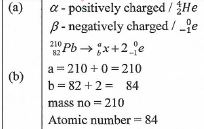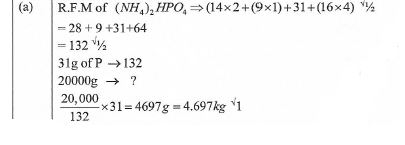QUESTIONS
-
- Define a soluble base.(1 mark)
- Aqueous solutions of 2M ethanoic acid and 2M nitric(V) acid were tested for electrical conductivity. Which solution is a better conductor of electricity? Explain. (2 marks)
-
- Explain why it is not advisable to prepare a sample of carbon(IV) oxide using barium carbonate and dilute sulphuric(VI) acid.(2 marks)
- State a method that can be used to collect dry carbon(IV) oxide gas. Give a reason.(1 mark)
- The following are formulae of organic compounds. Use the formulae to answer the questions that follow:
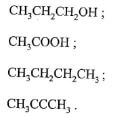
- Select:
- two compounds which when reacted together produce a sweet smelling compound.(1 mark)
- an unsaturated hydrocarbon(1 mark)
- Name the compound selected in (a)(ii).(1 mark)
- Select:
- One of the allotropes of sulphur is rhombic sulphur.
- Name the other allotrope of sulphur.(1 mark)
- Draw a diagram to show the shape of the allotrope named in (a) above.(1 mark)
- Write an equation for the reaction between concentrated sulphuric(VI) acid and sulphur.(1 mark)
- Describe an experiment to show that group one elements react with cold water to form alkaline solutions.(3 marks)
-
- State Graham's law of diffusion.(1 mark)
- Explain why a balloon filled with helium gas deflates faster than a balloon of the same size filled with argon gas.(2 marks)
- 30.0 cm3 of aqueous sodium hydroxide containing 8.0g per litre of sodium hydroxide were completely neutralised by 0.294 g of a dibasic acid. Determine the relative formula mass of the dibasic acid. (Na = 23.0; 0 = 16.0; H = 1.0)(3 marks)
- Study the flow chart in Figure 1 and answer the questions that follow.

Figure 1
Gas N forms a white suspension with aqueous calcium hydroxide.- Name the anion present in the potassium salt.(1 mark)
- Write an ionic equation for the formation of solid M.(1 mark)
- Give one use of gas N.(1 mark)
- An experiment was carried out to determine the presence of substances P, Q, R and S in mixture T. The results obtained are shown in Figure 2.
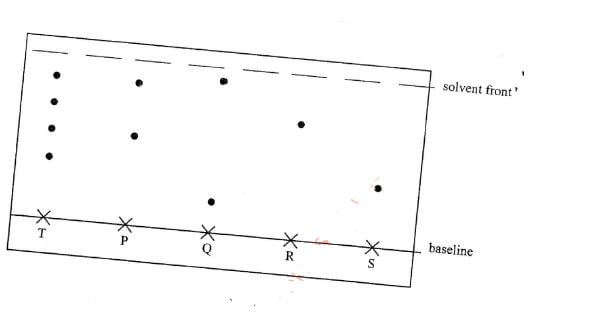
Figure 2- Name the mothod of separation illustrated in Figure 2.(1 mark)
- Select:
- one substance which contains a component not present in T.(1 mark)
- a substance which is least soluble in the solvent used.(1 mark)
- Using iron filings, describe an experiment that can be conducted to show that oxygen is present in air.(3 marks)
-
- Element U has atomic number 12 while element V has atomic number 16. How do the melting points of their oxides compare? Explain.(3 marks)
- When ethene gas is compressed at a high temperature, a solid is formed.
- Give the name of the solid.(1 mark)
- Explain why it is not advisable to allow the solid to accumulate in the environment.(2 marks)
- In the Haber process, nitrogen reacts with hydrogen according to the following equation.
3H2(g) + N2(g) → 2NH3(g); ΔH = -92kJ mol-1- What would be the effect of adding a catalyst on the position of the equilibrium?(1 mark)
- Explain why it is not advisable to use temperatures higher than 773 K in the Haber process.(2 marks)
- Figure 3 shows a set-up used by a student to prepare dry chlorine gas in the laboratory

Figure 3
Identify three mistakes in the set-up, and give a reason for each.(3 marks) - You are provided with solid potassium hydrogen carbonate. Describe how a solid sample of potassium nitrate can be prepared.(3 marks)
- Metal X and Y have standard electrode potentials of -0.13 V and -0.76V respectively. I metals were connected to form a cell as shown in Figure 4.
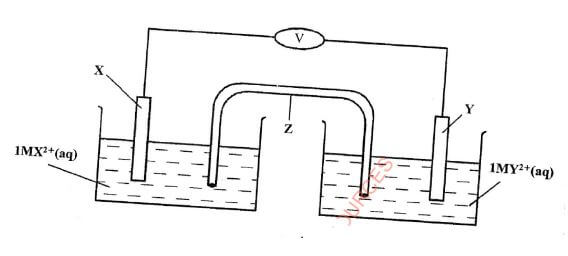
Figure 4- Name the part labelled Z.(1 mark)
- State one function of the part labelled Z.(1 mark)
- Calculate the e.mf of the cell.(1 mark)
- Figure 5 represents a grid that is part of the periodic table. Study it and answer the questions that follow. The letters are not the actual symbols of the elements

Figure 5- Write the electron arrangement of element C.(1 mark)
- On the grid provided, show with a tick (√) the position of element D whose atomic number is 18.(1 mark)
- Element E is more reactive than A. Explain.(1 mark)
-
- Define molar heat of displacement.(1 mark)
- The following ionic equation represents the reaction between metal Y and an aqueou solution of Z2+.
Z2+(aq) + Y(s) → Z(s) + Y2-(aq); ΔH = -ve
Draw an energy level diagram to represent the reaction. (2 marks)
-
- Give the symbols of the two charged particles emitted by a radioactive isotope.(1 mark)
- An isotope
disintegrates by emitting two beta particles. Determine the mass number and atomic number of the resulting nuclide.
- mass number:(1 mark)
- atomic number:(1 mark)
-
- Zinc reacts with hydrochloric acid according to the following equation.
Zn(s) + 2HCl (aq) → ZnCl2(aq) + H2(g)
Identify the reducing agent. Give a reason for the answer.(2 marks) - Iron sheets are dipped in molten zinc to prevent rusting. Name this process.(1 mark)
- Zinc reacts with hydrochloric acid according to the following equation.
- Study the set-up in Figure 6 and answer the questions that follow.

Figure 6- Name the substance that was collected in tube P.(1 mark)
- Write an equation for the reaction which occurs in tube Q in the first few minutes of the experiment.(1 mark)
- Give a suitable conclusion for the experiment in the set-up.(1 mark)
- You are provided with the following: thermometer, boiling tube, beaker, Bunsen bumer, pure substance X whose boiling point is about 80°C, water and any other apparatus that may be required. Draw a labelled diagram of the set-up that can be used to determine the melting point of X(3 marks)
- Explain why it is important to put off a non-luminous flame immediately after use.(2 marks)
-
- Name two ores of iron(1 mark)
- Describe how the amount of iron in a sample of iron(III) oxide can be determined.(2 marks)
- Explain why a solution of sodium chloride conducts electricity while that of sugar does not.(2 marks)
- Explain why commercial indicators are preferred to flower extracts as acid-base indicators.(2 marks)
- (NH4) HPO4 is a fertiliser used by farmers to boost their crop production.
- Calculate the mass of phosphorus in a 20 kg packet of (NH4)2HPO4.
(N = 14.0; H = 1.0; P=31.0; 0 = 16.0)(2 marks) - State one advantage of this fertilizer, (NH4) HPO4 over urea (CO(NH2)2).(1 mark)
- Calculate the mass of phosphorus in a 20 kg packet of (NH4)2HPO4.
- Distinguish between empirical and molecular formula of a compound (2 marks)
MARKING SCHEME
-
- A soluble base is a substance that dissociates in water to produce hydroxide ions as the only negative ions.
- Nitric(V) acid.
This is because nitric(V) acid is a strong acid and dissociates completely in solution producing many H+ ions.
-
- The reaction starts but soon stops.
This is because the insoluble barium sulphate produced forms a coating on the surface of the barium carbonate preventing further reaction and evolution of carbon(IV) oxide gas. - Downward delivery.
Carbon(IV) oxide is denser than air.
- The reaction starts but soon stops.
-
-
- CH3CH2CH2OH and CH3COOH
- CH3CCCH3
- But-2-yne
-
-
- Monoclinic sulphur/beta sulphur/prismatic sulphur
-

- S(s) +2H2SO4(l) → 3SO2(g) + 2H2O(g)
-
- Place a small piece of sodium metal on water in a trough.
- When the reaction stops, drop a strip of red litmus paper to the resulting solution.
- The red litmus paper turns blue showing that the resulting solution is alkaline. (Any indicator used)
- Graham's Law of diffusion
- The rate of diffusion of a gas is inversely proportional to the square root of its density at constant temperature and pressure.
- Helium is less dense than argon hence it diffuses out of the balloon faster than argon
-
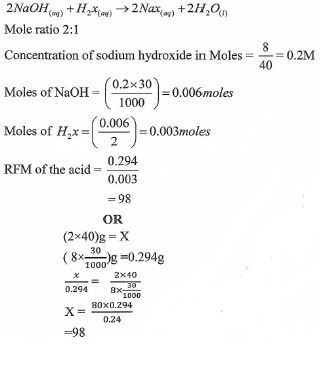
-
- Carbonate (C032-)
- Ba2+ (aq) + CO32- (aq) → BaCO3(s)
-
- Making soft drinks/aerated drinks;
- In refrigeration;
- In extinguishing fires;
- Making baking powder;
- Manufacture of sodium carbonate;
- Cloud seeding.
(Any 1 correct = 1 mark)
-
- Chromatography paper chromatography
-
- Q
- S
-
- Wet a measuring cylinder gas jar and sprinkle some iron filings on the wet surface. Remove the excess iron filings;
- Invert the measuring cylinder in a trough of water;
- Take the reading of the air column in the measuring cylinder. Leave the set-up for 2 days;
- Read and record the volume of the air column;
- The volume of the air reduced and the grey filings changed to a brown substance;
- The oxygen in the air reacted with the iron fillings to form rust.
-
- The oxide of U has higher melting point than the oxide of V;
- This is because the oxide of U is a solid with ionic bonds hence requires a lot of energy to melt;
- The oxide of V is a gas hence requires little energy to melt/break molecular forces of attraction.
-
- Polythene / Polyethene
- It is non-biodegradable, hence pollutes the environment.
-
- No effect/does not affect the position of the equilibrium.
- Forward reaction is exothermic, excessive temperatures would favour the backward reaction therefore lowering the yield of ammonia.
-
- one reagent is missing, hence reagents provided cannot produce chlorine;
- Wrong drying agent
- Calcium oxide will react with the chlorine gas;
- Incorrect method of gas collection
- No gas will be collected / chlorine is denser than air.
-
- Measure a certain volume of dilute nitric(V) acid and place it in a beaker;
- Add potassium hydrogen carbonate little by little as the mixture is stirred until effervescence stops;
- Evaporate the solution to saturation and allow to cool for crystals to form;
- Dry the crystals in between filter papers.
-
- salt bridge
- Provides electrical contact between the electrodes//completes the circuit;
- Provides cations and anions to replace those used up.
(Any 1 correct @ 1 mark)
e.m.f of cell-Eθreduced - Eθoxidized
=-0.13 - -0.76 = +0.63V
-
- 2.8.4
- period 3, group 8
- E has a bigger atomic radius than A/the valence electrons of element E are further from the nucleus, hence loosely held by the positive nucleus and requires less energy to be removed during reaction.
OR
A has a smaller atomic radius than E /the valence electrons of element A are closer to the nucleus, hence strongly held by the positive nucleus and requires more energy to be removed during a reaction.
-
- Molar heat of displacement is the enthalpy change that occurs when one mole of a substance is displaced from its ions in solution
-
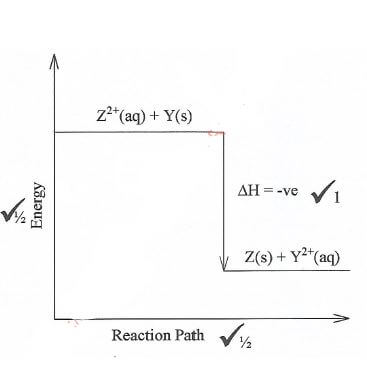
-
-
- Reducing agent - Zn
The oxidation number of Zn increased from 0 to +2
OR
Zn
Zn loses electrons form zinc ions/Zn is oxidized to Zn2+ - Galvanization
- Reducing agent - Zn
-
- Water
- CO2(g) + Ca(OH)2(aq) → CaCO3(s) + H2O(l)
- Burning candle /organic matter produces water and carbon(V) oxide.
OR
Candle contains carbon and hydrogen / candle is a hydrocarbon
-
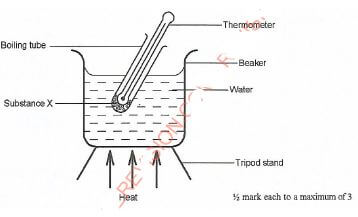
- A non-luminous flame is invisible, hence it should be put off to avoid being accidentally burned.
-
- Haematite;
Magnetite;
Siderite.
(Any 2 correct @ mark) - Weigh the Iron(III) oxide together with a crucible;
Heat the Iron(III) oxide and coke to a constant mass;
Cool and re-weigh residue and crucible
The difference in mass is weight of the iron.
- Haematite;
- A solution of sodium chloride contains ions which are free to conduct electricity while that of sugar contains molecules hence cannot conduct electricity.
- The composition of commercial indicators remains constant, hence gives consistent results.
The composition of flower extracts change with time giving inconsistent results. -
-
- (NH4)2HPO4, has two nutrients available to crops, nitrogen and phosphorus, urea has only nitrogen.
-
- Empirical formula shows the simplest whole number ratio of the moles of atoms of different elements in a compound while the molecular formula shows the actual number of atoms of various elements present in one molecule of the compound.
Join our whatsapp group for latest updates
Tap Here to Download for 50/-
Get on WhatsApp for 50/-
Download KCSE 2018 Chemistry Paper 1 with Marking Scheme.
Tap Here to Download for 50/-
Get on WhatsApp for 50/-
Why download?
- ✔ To read offline at any time.
- ✔ To Print at your convenience
- ✔ Share Easily with Friends / Students

